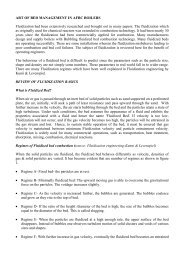Create successful ePaper yourself
Turn your PDF publications into a flip-book with our unique Google optimized e-Paper software.
PART 1- MIXING NOZZLE STUDIES<br />
The customer desired th<strong>at</strong> we do someth<strong>in</strong>g about the dust nuisance. We conducted air flow studies<br />
with and without coal. We even dismantled some mix<strong>in</strong>g nozzles to understand wh<strong>at</strong> makes to choke<br />
the l<strong>in</strong>es.<br />
Mix<strong>in</strong>g nozzle suction <strong>at</strong> thro<strong>at</strong><br />
We checked whether there is suction <strong>at</strong> venturi thro<strong>at</strong> area with & without fuel. We found th<strong>at</strong> there<br />
was +ve pressure when the fuel was dropped. Positive pressure <strong>at</strong> thro<strong>at</strong> can cre<strong>at</strong>e dust deposits <strong>in</strong><br />
fuel feed chutes. Slowly lumps beg<strong>in</strong> to form and these lumps <strong>in</strong>terrupt the fuel flow <strong>in</strong> l<strong>in</strong>es.<br />
Positive pressure could occur if the PA fan is undersized or if the thro<strong>at</strong> size is larger than<br />
requirement. Table below shows oper<strong>at</strong><strong>in</strong>g with two PA fans could cre<strong>at</strong>e more suction <strong>at</strong> thro<strong>at</strong>.<br />
PA damper %<br />
PA header pr,<br />
mmWC<br />
MX nozzle <strong>in</strong>let<br />
pr, mmWC<br />
Thro<strong>at</strong><br />
mmWC<br />
No coal – with one PA fan<br />
70% open 1030 990 -120 530<br />
100% 1092 1055 -170 530<br />
With coal- with one PA fan<br />
70% open 1028 990 ± 125 530<br />
100% 1075 1055 ± 90 530<br />
With coal- with two PA fans<br />
35% open 1300 1250 -260 to -60 560<br />
pr,<br />
MX nozzle<br />
outlet pressure,<br />
mmWC<br />
The mix<strong>in</strong>g nozzle works on the Bernoulli pr<strong>in</strong>ciple. Suction should be available <strong>at</strong> thro<strong>at</strong> when the<br />
fuel drops <strong>in</strong>. M<strong>in</strong>or pressuriz<strong>at</strong>ion up to + 25 mmWC can be accepted and will not be cre<strong>at</strong><strong>in</strong>g dust<br />
nuisance. If not, the fuel would back out caus<strong>in</strong>g troubles <strong>in</strong> l<strong>in</strong>e chok<strong>in</strong>g / feed chute chok<strong>in</strong>g.<br />
Sufficient suction would not develop when the air flow is less / mix<strong>in</strong>g nozzles are not as per design.<br />
PA fan capacity<br />
Then we checked th<strong>at</strong> the fan design parameters and we found th<strong>at</strong> the PA fan had good amount of<br />
marg<strong>in</strong> too. When we oper<strong>at</strong>ed two PA fans there was enough suction <strong>at</strong> thro<strong>at</strong>. There was a need to<br />
establish the air flow r<strong>at</strong>e tak<strong>in</strong>g place <strong>in</strong> present condition. This was because the fan was consum<strong>in</strong>g<br />
more power than wh<strong>at</strong> was as per test <strong>at</strong> MCR flow.<br />
Mix<strong>in</strong>g nozzle as a flow measurement device<br />
Venturi tube is a flow measur<strong>in</strong>g device and regularly be<strong>in</strong>g used by eng<strong>in</strong>eers. The Bernoulli<br />
pr<strong>in</strong>ciple is used here to measure the air flow. S<strong>in</strong>ce we measured the pressures <strong>at</strong> <strong>in</strong>let, outlet and <strong>at</strong><br />
thro<strong>at</strong> without / with air flow, the air flow can be calcul<strong>at</strong>ed us<strong>in</strong>g Bernoulli pr<strong>in</strong>ciple. The<br />
fundamental pr<strong>in</strong>ciple and our f<strong>in</strong>d<strong>in</strong>gs are as below.<br />
The tapp<strong>in</strong>gs available <strong>at</strong> mix<strong>in</strong>g nozzle <strong>in</strong>let, thro<strong>at</strong> and <strong>at</strong> outlet were provided with manometer.<br />
The pressure profiles were taken and presented <strong>in</strong> table 1. Apply<strong>in</strong>g Bernoulli equ<strong>at</strong>ion we could f<strong>in</strong>d<br />
out the air flow.


















